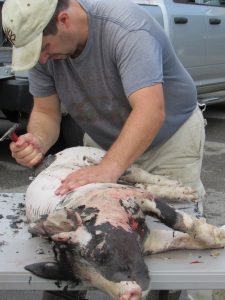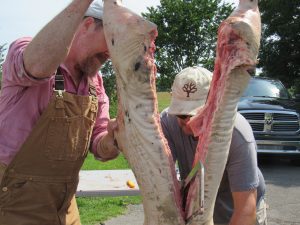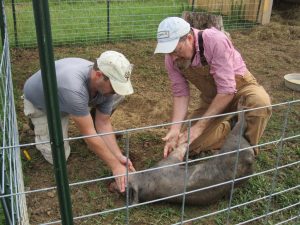The ideal: When you look at a diagram, you see that the proper placement of a killing shot is just off center of an X formed by two lines that run from each ear to the opposite eye. The reality: When you’re faced with a pen full of weanling pigs that never stand still for more than a moment as they jostle for feed, you discover that that perfectly executed shot of the drawing is nothing more than a pipe dream.
At only 65 pounds, the chosen pig of friends had been handed down a sentence of early termination, the result of an already grossly distended hernia that was growing larger by the day. On a pet or a human, repair would be a straightforward, albeit expensive procedure. On a hog destined for slaughter in another six months, it was a foregone decision to move the timetable forward.
Some years back, our farm had a 200-pound barrow that broke its back in a rugby scrum with its brethren. A friend came over and assisted me in the killing and butchering. The hog, located at the far end of a two-acre wooded lot, had to be dragged across the uneven ground to the scalding pot. “Dead weight” has never been such an apt description.
If you’ve never done it, dragging a dead animal is a most peculiar exercise. It rolls about and shifts weight without warning, the bulk animated and yet unliving. (The dead can be such hard work.) No matter how often I have to do it, manhandling a carcass still comes as a disquieting reminder, one that manages to be both alien and, with familiar elements of the personal, foreshadowing.
At our friend’s farm, with Cindy and Sabine looking on, Michael hit the mark on the second try. He and I both sprang on the now stunned animal. I plunged the sticking knife in above the sternum. Pushing against bone for leverage, I severed one of the carotid arteries. The pig bled out on the grass. The other weanlings showed no interest in his fate and continued instead to gorge on the corn we had spread as bait.
Over the next couple of hours, Michael and I cleaned, scalded, scraped, eviscerated, cut, and packaged the pig into smaller primal cuts. Our task finally completed, the table cleaned, and the offal bagged and removed, we then retired to the shade for a beer.
Butchering is never as tidy as the illustrations show. My clothes were blood-splattered, and spare bits of hair from the vigorous skin scraping adhered to the far parts of my anatomy. If I’d been stopped by a state trooper on my way home, a serious inquiry followed by a search of the truck would inevitably have ensued.
Some hours later, back at our farm, Cindy positioned the livestock trailer at the entrance of our wooded hog paddock. Three 300-pound animals that need to be loaded for a trip to the processor on Tuesday reside there. (Although advocates of self-sufficiency, we believe that such large-scale butchery is best left to a professional.)
Such are the cycles on the farm, as mirrored in life: beginnings and endings and beginnings again. As the long day closed, we found ourselves sitting quietly in the back yard, idly gazing out at the hill pasture. The soon-to-be-full moon was rising in the east with Jupiter in a slow-motion chase. The wind tossed the trees on the far Southern horizon, and it was some minutes later before the breeze found us. The last light in the sky, a soft lavender in the west, finally diminished. With some reluctance, not wanting to release the day, we got up and went inside to read for the closing hour before bedtime.
…………………………………………………….
Reading this week: The Whole Okra (Smith), Deep Work (Newport), Letters From 

 Europe (Thomson). The latter is an account, through letters back home, of the author’s book-buying trip to Europe on behalf of Ohio Wesleyan University, published in 1856.
Europe (Thomson). The latter is an account, through letters back home, of the author’s book-buying trip to Europe on behalf of Ohio Wesleyan University, published in 1856.
